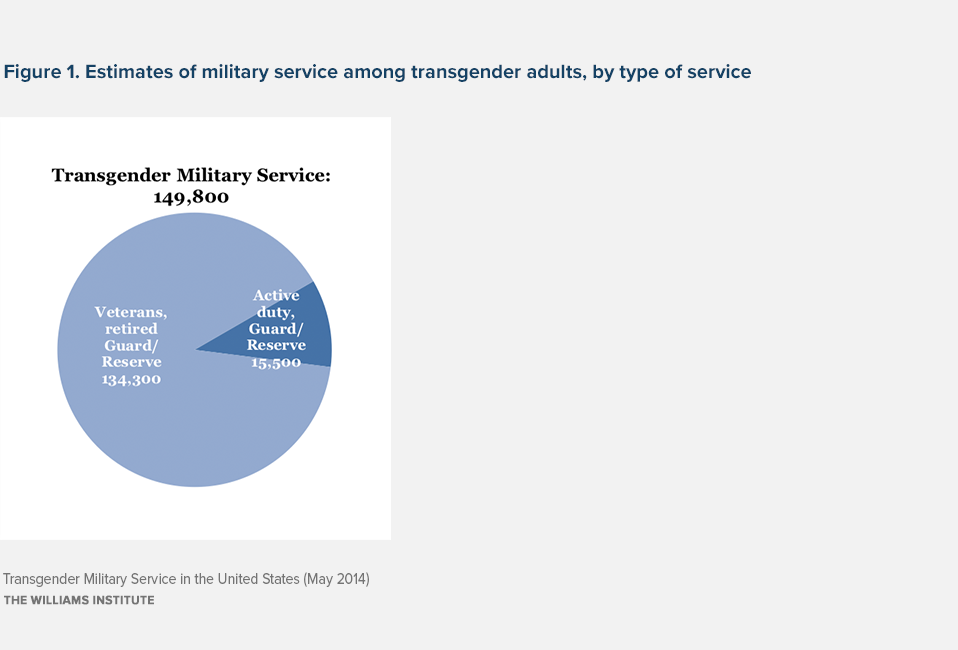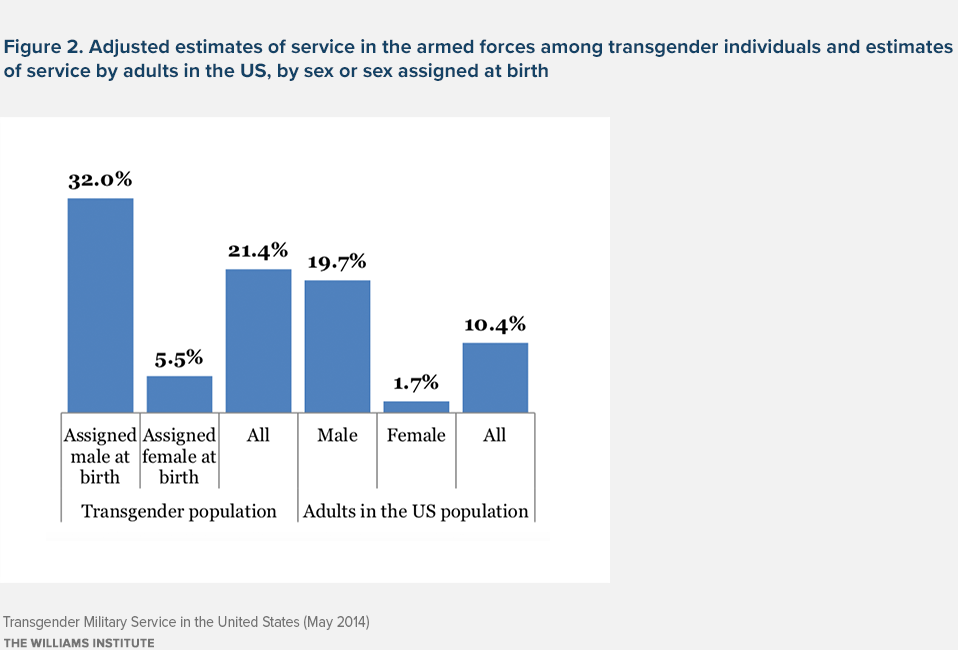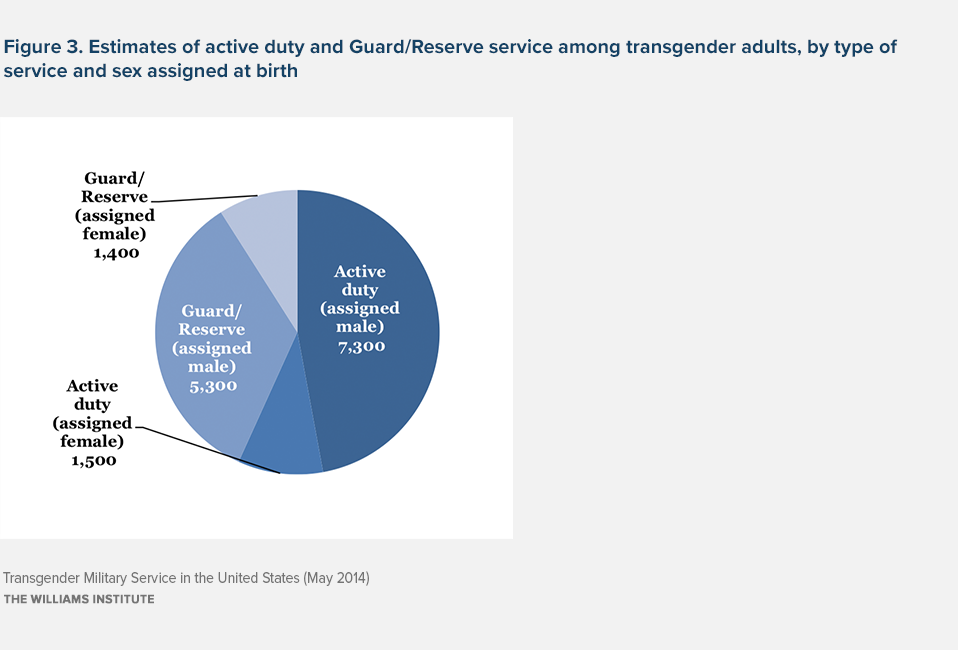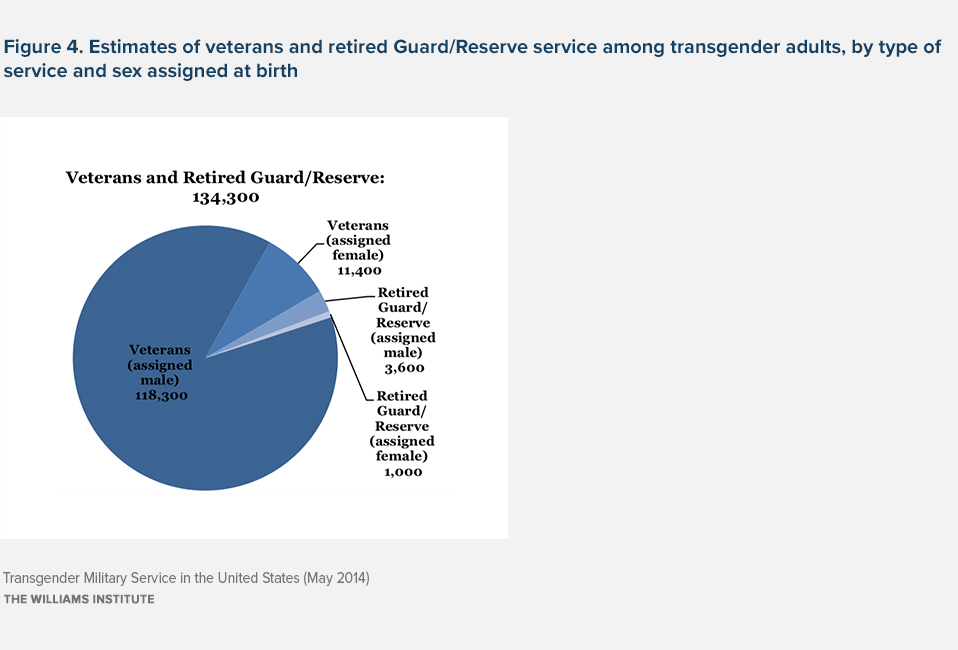How Do Active Service Members Feel About Transgenders
Brief
Transgender War machine Service in the The states
May 2014
- Overview
- Highlights
- Data Points
- Brief
- Cursory
This study uses data from several sources to judge the number of transgender people who have served in the U.South. war machine. Estimates are provided for those who are on active duty or serving in the Baby-sit or Reserve forces, and the number who are veterans or retired from Guard or Reserve service.
Although "Don't Ask, Don't Tell" was repealed in 2011, armed services policies still exclude transgender people from serving openly.
Transgender individuals are about twice as likely as all adults in the U.S. to take served their state in the military.
Transgender individuals assigned female at birth are nearly three times more probable than all adult women to take served.
Introduction
This research brief offers analyses from several data sources to estimate the number of transgender individuals who take served in the US military machine, including the number who are likely on agile duty or serving in the Guard or Reserve forces, and the number who are veterans or retired from Baby-sit or Reserve service.
On September twenty, 2011, the military policy known as "Don't Enquire, Don't Tell" (DADT) ended, assuasive gay, lesbian, and bisexual service members to serve openly. Nevertheless, armed forces medical policies however exclude transgender people from serving openly in the US armed forces. These medical policies lay out exclusions for what are deemed to be "psychosexual disorders," including transsexualism, cross-dressing, or a history of gender transition. Therefore, transgender individuals who wish to join the Us armed forces are prohibited from doing so if their transgender status is known. Furthermore, those already serving tin can be medically discharged if suspected of being transgender.
Our estimates suggest that approximately fifteen,500 transgender individuals are serving on agile duty or in the Baby-sit or Reserve forces. Nosotros too estimate that at that place are an estimated 134,300 transgender individuals who are veterans or are retired from Guard or Reserve service (come across Figure i).

Data and methodology
The master information source for the estimates of transgender military service is the National Transgender Discrimination Survey (NTDS), which was conducted past the National Gay and Lesbian Task Force and the National Heart for Transgender Equality. This 70-item survey was distributed in cooperation with over 900 organizations across the United States and also was announced through listservs and online communities. It was made available both online and on paper in English language and Spanish. The survey was fielded over six months beginning in fall 2008 and resulted in vi,546 valid responses, which is the largest sample of transgender people in the Us to date. Respondents answered questions about a broad array of topics, including whether they had served in the U.s. armed forces in the following question:
Have yous ever been a member of the armed forces?
- Yep
- No
- I was denied entry because I am transgender/gender non-befitting
Every bit a purposive sample of transgender adults in the United states, estimates derived directly from the NTDS could be biased if the truthful demographic characteristics of the transgender population differ from the characteristics of transgender respondents to the survey. For example, relative to the U.s. population, NTDS respondents are younger and study higher levels of instruction. Both factors would be associated with lower levels of lifetime military service. Given the lack of demographic information on the transgender population derived from population-based sources, information technology is not possible to determine if the historic period and educational attainment levels of NTDS respondents are different from the general United states of america population because younger and more than educated transgender individuals were more than likely than others to have completed the survey (known as selection bias) or if transgender individuals are, in fact, younger and more likely to accept higher levels of education compared to the general population.
More than 93% of NTDS respondents provided information using an online spider web-based survey. Samples from online surveys are ofttimes biased toward more than educated respondents. Reisner and colleagues (2014) found that NTDS respondents who used newspaper survey forms tended to report lower income and educational levels. It is possible that the web-based approach of the NTDS contributed to selection bias toward higher education, which would result in a bias toward lower military service.
To address these possible biases, the estimates of armed services service among the transgender population in these analyses suit the characteristics of NTDS respondents such that they have the age and educational attainment patterns of the U.s.a. population. Armed forces service rates also differ by race and ethnicity. Unfortunately, the race and ethnicity categories used in the NTDS are not consequent with those used in Demography Bureau surveys. Educational attainment, like race and ethnicity, captures some of the variations in socio-economic status which may contribute to differences in military service rates.
This adjustment effectively assumes that being transgender is not associated with age or educational attainment. It also leads to estimates of military service rates for the transgender population that are slightly higher than the unadjusted calculations from the NTDS, which includes younger and more educated individuals who are less probable to study military service than older or less educated individuals. Alternatively, if the NTDS age and educational patterns are actually reflective of the transgender population in the US, then the adjustment process would produce estimates of transgender military service that may be higher than true military service rates amidst transgender individuals.
Population age and educational attainment data are derived from analyses of the U.s. Census Bureau's 2011 American Community Survey.
The estimation procedure also assumes that NTDS respondents who report that they were assigned male at birth share the historic period and educational attainment patterns of the developed male population in the US while NTDS respondents that were assigned female at birth share the patterns of the developed female population. We make this assumption and study differences based on the sex assigned at birth because information technology is likely that most transgender veterans and service members would take entered and served in the military machine according to their sex assigned at birth. Estimates for the total number of transgender individuals who are currently or have ever served in the military are derived separately for those assigned male at birth (approximately threescore% of the full NTDS sample) and those assigned female at nascency (approximately forty% of the full NTDS sample).
Men are substantially more likely than women to serve in the US military. The estimates of transgender military service presume that, consequent with findings from the NTDS, approximately 60% of the transgender population was assigned male person at birth while 40% was assigned female at nascence. If, in fact, the transgender population is comprised of a larger portion of individuals assigned male at nativity, so the estimation procedure likely understates transgender war machine service. Conversely, if those assigned female at nascency are actually a larger proportion of the transgender population, and then the interpretation process may overstate transgender military service.
The estimation begins by computing the percent of NTDS respondents who report war machine service by their age and educational attainment status. Respondents are separated into v age categories and v educational attainment categories as follows:
- Age (a)
- 18-24
- 25-44
- 45-54
- 55-64
- 65 and older
- Education (eastward)
- Less than high schoolhouse
- Loftier schoolhouse diploma
- Some college
- College caste
- Graduate degree
The percent of NTDS respondents who written report service in the armed forces is calculated for those in each age/education category (milae). Data from the 2011 American Community Survey Public Use Microdata Sample (ACS PUMS) are used to calculate the per centum of adults age xviii and older who are within each age and didactics category (Pae).
The adjusted estimate for transgender military service MILadj determines what the military service patterns of NTDS respondents (separated by sexual practice assigned at birth) would be if they had the same age and educational attainment levels of the male and female person population in the US by calculating a weighted average as follows:

In the United states, approximately v.viii% of all adults who have ever served in the armed forces are currently on active duty and 4.4% are now serving in the Guard or Reserve. An estimated 86.8% are veterans who served on active duty in the by and iii.0% are retired from Baby-sit or Reserve service. The number of transgender adults in each category is estimated past applying these same proportions to the estimated number of transgender individuals who report any service in the military.
Transgender armed services service
Analyses of the unadjusted NTDS information evidence that 29.half-dozen% of respondents assigned male at nascency reported that they accept served in the armed forces forth with 6.0% of those assigned female person at birth. In total, xx% of NTDS respondents reported some type of military service.
Assuming NTDS reported rates of war machine service are truthful of the transgender population in the Us, Figure ii shows adjusted estimates of military service for the transgender population (separated by sex assigned at birth) and for adult men and women in the United states of america. When figures are adjusted such that the age and educational patterns of the Usa adult male and female population are applied to the NTDS sample, an estimated 21.4% of transgender individuals take served in the military machine. The adapted estimates suggest that 32.0% of those assigned male at nascence and 5.five% of those assigned female at birth have served.

By comparing, approximately x.seven% of adults in the U.s. have served. This implies that transgender individuals are near twice every bit likely as adults in the U.s. to accept served their country in the military. Transgender individuals assigned female at nativity are most 3 times more likely than all developed women and those assigned male at birth are 1.half dozen times more probable than all adult men to serve.
Gates (2011) estimates that approximately 700,000 adults in the Us are transgender.viii If, similar in the NTDS, this group is threescore% male person assigned at nascency and 40% female assigned at nascence, then the estimates above imply that in that location are approximately 150,000 transgender adults in the US who are now serving or who accept served in the war machine.
In the US, 5.four% of men who report any war machine service are on active duty along with 9.8% of women. Applying these figures to the estimates of transgender military service would imply that approximately 8,800 transgender individuals are currently on active duty, of whom nearly vii,300 are assigned male at birth and about 1,500 are assigned female at nascence. The estimates also suggest that 6,700 transgender individuals are serving in the Guard or Reserve forces, of whom 5,300 are assigned male at birth and ane,400 are assigned female at birth (see Effigy 3).

The estimates besides suggest that there are more than 134,000 transgender individuals in the U.s. who are veterans or have retired from Guard or Reserve service (see Figure 4).

These estimates imply that approximately 0.half dozen% of adults who study service in the military machine are transgender.
Discussion
Data that allow for a direct tabulation of the number of transgender individuals who serve in the U.s. military merely do not exist. The estimates in this research brief rely on a variety of assumptions that could bear on their accurateness.
Men are more likely to serve in the military machine than are women. If individuals assigned male person at nascency are, in fact, more than 60% of the transgender population, and then transgender military service is probable understated in these estimates. Conversely, if those assigned female at nativity stand for more than 40% of the transgender population, then estimates of transgender war machine service are probable overstated.
The estimates also assume that the transgender population shares the age and educational attainment characteristics of the US population. If the true transgender population is younger and more educated than the US population (consistent with the NTDS sample), and then the estimates could exist overstating transgender armed forces service.
Despite these possible biases, the estimates certainly suggest that transgender individuals are office of the US armed forces, perhaps in portions that exceed that of the general population.
There is other evidence that transgender individuals stand for a larger portion of those in the armed services than their proportion amid adults in the US population. In a survey of transgender people assigned male at birth, Shipherd et al. institute that xxx percent had served in the military, which is like to military service among transgender people assigned male at birth in the NTDS.9 A recent written report by Blosnich et al. reviewed all wellness records of veterans receiving health care through the Veterans Wellness Assistants (VHA) from 2000 through 2011 and found a prevalence of Gender Identity Disorder (GID) five times that of the US full general population.x Though individuals with GID diagnoses may or may non identify as transgender, the substantially higher prevalence of GID amid veterans in the VHA organisation provides further bear witness that transgender people are over-represented in the United states of america armed forces.
Download the brief
How Do Active Service Members Feel About Transgenders,
Source: https://williamsinstitute.law.ucla.edu/publications/trans-military-service-us/
Posted by: garciamanneve.blogspot.com


0 Response to "How Do Active Service Members Feel About Transgenders"
Post a Comment